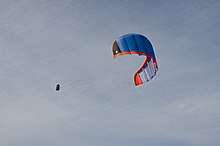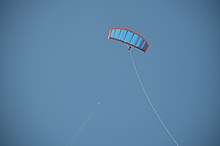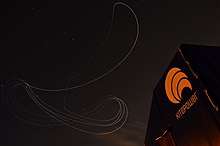Kitepower
Kitepower is a registered trade mark of the Dutch company Enevate B.V. developing mobile airborne wind power systems. Kitepower was founded in 2016 by Johannes Peschel and Roland Schmehl[1][2] as a commercial spin-off [3] from the Delft University of Technology’s airborne wind energy research group[4] established by the former astronaut Wubbo Ockels. The company is located in Delft, Netherlands, and currently comprises 18 employees (2018).
| B.V. | |
| Industry | Wind Energy, Renewable Energy |
| Founded | 2016 |
| Founders | Johannes Peschel, Dr. Roland Schmehl |
| Headquarters | Delft, Netherlands |
Number of employees | 18 |
| Website | https://kitepower.nl/ |
System




Based on its first 20 kW (rated generator power) prototype, Kitepower is currently developing a scaled-up 100 kW system for the purpose of commercialization.[5] Funding is provided by the European Commission's Horizon 2020 Fast Track to Innovation [6] project REACH[7][8] in which the company is collaborating with Delft University of Technology and industry partners [9] Dromec, Maxon Motor and Genetrix.
Working principle
The Kitepower system consists of three major components:[10][11][12] a lightweight, high-performance kite,[13] a load-bearing tether and a ground-based electric generator. Another important component is the so called kite control unit and together with the according control software for remotely steering the kite.[14]
For energy production, the kite is operated in consecutive "pumping cycles" with alternating reel-out and reel-in phases:[11][15] during reel-out the kite is flown in crosswind maneuvers (transverse to the incoming wind, commonly figure of eight patterns). This creates a large pulling force which is used to pull the tether from a ground-based drum that is connected to a generator. In this phase electricity is generated. Once the maximum tether length is reached, the kite is reeled back, but this time depowered,[16] such that it can be retracted with a low aerodynamic resistance. This phase consumes a small fraction of the previously generated power such that in total net energy is produced. The electricity is buffered by a rechargeable battery unit, or, in a kite park configuration, several systems can be operated with phase shifts such that the battery capacity can be reduced.[17]
Technology context
Airborne wind energy promises to be a cost-competitive solution to existing renewable energy technologies.[18][19] The main advantages of the airborne wind energy technology are the reduced material usage compared to conventional wind turbines (no foundation, no tower) which allows reaching for higher altitudes and makes the systems more mobile in terms of location, and considerably cheaper in construction.[20] Challenges are robustness and reliability of the flying wind energy system[21]and the airspace requirements of the technology.[22] A considerable body of scientific literature and patents has been developed.[23]
Applications
For the art project Windvogel of Dutch artist Daan Roosegaarde the Kitepower system was operated also during night, using a light-emitting tether [24]
Awards
- YES!Delft Launchlab 2016 [25]
- Dutch Defense Innovation Competition 2016 [26]
- YES!Delft Incubation Program 2017 [27]
See also
References
- Schmehl, Roland. "Finally, kites have grown up". TEDxDelft 2012. Retrieved 25 May 2018.
- Anderson, Mark (2019-02-26). "Ready Flyer One: Airborne Wind Energy Simulations Guide the Leap to Satisfying Global Energy Demand". IEEE Spectrum. Retrieved 2 March 2019.
- Company Portfolio Delft Enterprises. Retrieved 2017-09-04.
- Airborne Wind Energy Research Delft University of Technology. Retrieved 2017-09-04.
- Breuer, Joep (28 September 2017). Commercializing A 100 kW, Mobile Airborne Wind Energy System: Potentially For Ships And Land Use. Energy Independent Electric Vehicles: Land, Water & Air. Delft, Netherlands: IDTechEx. Retrieved 25 May 2018.
- "Fast Track to Innovation Pilot". European Commission. 2014-09-24. Retrieved 26 May 2018.
- "Resource Efficient Automatic Conversion of High-Altitude Wind (REACH)". European Commission Community Research & Development Information Service (CORDIS). Retrieved 25 May 2018.
- REACH Project Retrieved 2017-09-04.
- REACH Partners, Retrieved 2017-09-04.
- "Kite power: towards affordable, clean energy". Faculty of Aerospace Engineering, Delft University of Technology. Retrieved 26 May 2018.
- van der Vlugt, Rolf; Peschel, Johannes; Schmehl, Roland (2013). "Design and Experimental Characterization of a Pumping Kite Power System" (PDF). In Ahrens, Uwe; Diehl, Moritz; Schmehl, Roland (eds.). Airborne Wind Energy. Green Energy and Technology. Berlin Heidelberg: Springer. pp. 403–425. doi:10.1007/978-3-642-39965-7_23.
- van der Vlugt, Rolf; Bley, Anna; Noom, Michael; Schmehl, Roland (2018). "Quasi-Steady Model of a Pumping Kite Power System". Renewable Energy. 131: 83–99. arXiv:1705.04133. doi:10.1016/j.renene.2018.07.023.

- Oehler, Johannes; Schmehl, Roland (2019). "Aerodynamic characterization of a soft kite by in situ flow measurement". Wind Energy Science. 4: 1–21. doi:10.5194/wes-4-1-2019.

- Roschi, Stefan. "Clean energy from high above". drive tech. maxon motor. Retrieved 25 May 2018.
- Fechner, Uwe; Schmehl, Roland (2018). "Flight Path Planning in a Turbulent Wind Environment" (PDF). In Schmehl, Roland (ed.). Airborne Wind Energy. Green Energy and Technology. Singapore: Springer. pp. 361–390. doi:10.1007/978-981-10-1947-0_15.
- Schmehl, Roland. "Simulated de-powering of a LEI tube kite for power generation". YouTube. Retrieved 26 May 2018.
- Faggiani, Pietro; Schmehl, Roland (2018). "Design and Economics of a Pumping Kite Wind Park" (PDF). In Schmehl, Roland (ed.). Airborne Wind Energy. Green Energy and Technology. Singapore: Springer. pp. 391–411. doi:10.1007/978-981-10-1947-0_16.
- Heilmann, Jannis; Houle, Corey (2013). "Economics of Pumping Kite Generators". In Ahrens, Uwe; Diehl, Moritz; Schmehl, Roland (eds.). Airborne Wind Energy. Green Energy and Technology. Berlin Heidelberg: Springer. pp. 271–284. doi:10.1007/978-3-642-39965-7_15.
- Harris, Margaret (2020-12-06). "The promise and challenges of airborne wind energy". Physics World. Retrieved 15 February 2020.
- "100 kW airborne wind energy system". Offgrid Energy Independence. 2017-06-14. Retrieved 26 May 2018.
- Salma, Volkan; Friedl, Felix; Schmehl, Roland (2019). "Improving reliability and safety of airborne wind energy systems". Wind Energy. 23 (2): 340–356. doi:10.1002/we.2433.

- Salma, Volkan; Ruiterkamp, Richard; Kruijff, Michiel; van Paassen, M. M. (René); Schmehl, Roland (2018). "Current and Expected Airspace Regulations for Airborne Wind Energy Systems" (PDF). In Schmehl, Roland (ed.). Airborne Wind Energy. Green Energy and Technology. Singapore: Springer. pp. 703–725. doi:10.1007/978-981-10-1947-0_29.
- Mendonça, Anny Key de Souza; Vaz, Caroline Rodrigues; Lezana, Álvaro Guillermo Rojas; Anacleto, Cristiane Alves; Paladini, Edson Pacheco (2017). "Comparing Patent and Scientific Literature in Airborne Wind Energy". Sustainability. 9 (6): 915. doi:10.3390/su9060915.

- "Windvogel". Studio Roosegaarde. Retrieved 25 May 2018.
- Kitepower Launchlab Prize YES!Delft. Retrieved 2017-09-04.
- Kitepower Innovation Competition Delft Enterprises. Retrieved 2017-09-04.
- Kitepower Incubation Program YES!Delft. Retrieved 2017-09-04